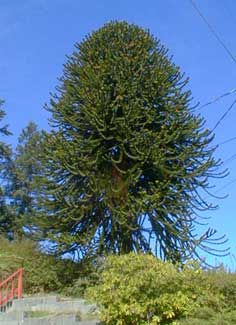
Monkey Puzzle Tree
"What a joy it is to plant a tree,
And from the sallow earth to watch it rise,
Lifting its emerald branches to the skies."
-Ella Wheeler Wilcox
(1850-1919)
(1850-1919)
When I was a small child Araucaria araucana, known as the Monkey Puzzle Tree, by right of its bizarre appearance & even by its appealing common name, captivated my imagination. With its odd looking evergreen limbs rather like the sweeping tails of spider monkeys, it was easy to imagine whole families of monkeys springing through the trees, hanging from one another's tails, chittering happily, though in fact the limbs would make very uncomfortable perches because closely covered with very spiny leaves.
About the time that my youngest childish fancies were giving way to juvenile scientific inquery, the Monkey Puzzle reclaimed my imagination when I learned this species was at least sixty million years old, dating the Cretaceous Period in the fossil record. That meant the last of the dinosaurs walked amidst these trees, which likely developed their bristly razor-sharp limbs & fruits to limit the browsings of prehistoric giants. It is the most primitive conifer in the world today.
At the end of the 18th Century, the tree was introduced into England by South American & Pacific Northwest botanical explorer Archibald Menzies (1754-1842). By the 1880s or 1890s it had already become a widely gardened plant in Victoria, British Columbia.
Thanks to the popularity of the Chilean tree in Pacific Northwest gardens from the late Victorian era onward, throughout my life there have been plenty of old mature specimens of Monkey Puzzles to be encountered. Although Granny Artemis & I don't have one in our own yard, the one shown in this photo is a block away in front of a hillside house, a dominant presence in our neighborhood.
Male & female Monkey Puzzles are separate trees. Females develop gigantic cones big as basketballs, with edible almond-sized seeds. These big tasty fatty & starchy seeds, as many as 200 in a single cone, do not spring from the cone until after it falls from the tree in autumn, thereby rendering harvest a cinch.
But if one of these cones falls on a vehicle, it can break a window or cave in a roof, & can be dangerous to anyone picnicking under the branches. The giant cones even damage the tree itself as they bang downward from the top, breaking branches, so female trees can lose their symmetry.
For all these reasons males are preferable in the garden landscape. The trees typically grow thirty to fifty feet in gardens, but females can be much bigger. In the mountains of Chile they can reach 150 feet, & were formerly used as lumber tree, though it is today far too rare to harvest. The ecologically devastating 2001/2002 forest fires in Chile's Malleco National Reserve destroyed seventy-one percent of the Monkey Puzzle Trees, some of them believed to have 2,000 years old. The Monkey Puzzle today survives in only two natural areas of the Andes.
Although generally disease-free, there is some risk of problems with monkey puzzles. In imperfect conditions of poor drainage, shade, root stress or root damage, monkey puzzles will shed their lower branches in their entirety, & a once-perfect specimen can become less than ideal.
They dislike having their roots disrupted in any way. During the post-war period of urban sprawl, many farms & old estates near cities got divided up for housing projects, & wherever the monkey puzzles were not just cut down to build yet another house on the spot, many that remained got their roots so banged up by heavy equipment of home builders that the trees began to die out of the landscape. Sickly browning dying specimens became way too common, & people began to think of them as delicate trees, though the trees would never have developed problems if developers had been more careful.